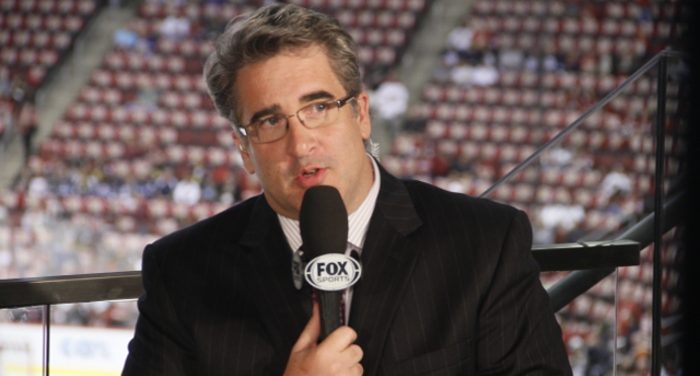The sagas of Manti Te'o and Lance Armstrong have spiraled across the media landscape over the past month, appearing everywhere from Oprah Winfrey's network to Katie Couric's show to Saturday Night Live. At first glance, the two stories are substantially different: Armstrong admitted to conducting an incredible doping regimen in his quest to win the Tour de France and then going after everyone who dared to suggest he was dirty. Te'o says he was deceived by a hoaxster and then lied about his relationship with his non-existent girlfriend to the media after being informed fo the scheme.
The stakes involved there aren't all that similar. However, there are plenty of common threads running through these stories, in how they were initially covered, how the lies were exposed, how the athletes reacted and how the media have reacted. These stories have both presented a window into the current state of sports coverage and raised some questions about where it may go in the future. Here are five media takeaways from the Te'o and Armstrong stories.
5. Some sports stories are well beyond sports now
Perhaps the most striking similarity between the Te'o and Armstrong cases is how far they expanded beyond sports, particularly in the shows and hosts chosen for their exclusive first on-camera interviews. While Couric has plenty of journalistic credibility from her days with 60 Minutes and the CBS Evening News, her talk show certainly isn't marketed as hard news or sports. Winfrey did a reasonably solid job of grilling Armstrong, but that's also a departure from her show's usual subject matter as well. Part of that may be a ploy by the camps of Armstrong and Te'o to pick a spot where the environment (and the audience) might be seen as a more receptive one, but Couric and Winfrey aren't just picking up any sports story that happens. These ones drew audiences well beyond sports long before the TV sitdowns.
The closest parallels to some of the Armstrong and Te'o coverage in non-sports media is what we've seen with various Hollywood celebrity meltdowns, and perhaps that's an indication of where some elements of sports media are going. There have been moves towards that with athletes like Tom Brady and Tim Tebow, who make tabloid headlines regardless of what they do on the field, and with TMZ's expanded coverage of sports. Both stories went well beyond sports, touching on cancer, charity, relationships and more, and they were narratives that resonated with a broader swathe of society. We may see more of their like in the future.
This isn't necessarily "entertainment media is ruining sports!" as there's always been at least some coverage of what athletes do off the field, going back to Broadway Joe Namath. What it does mean is that some massive sports stories aren't going to stay in the sports arena. When Te'o's interview with Couric aired Thursday, there were plenty of comments in my Twitter feed from sports media types who had never watched Katie before trying to find the show (I was in that boat too). Sports news probably isn't going to often happen on daytime talk TV, but the Te'o and Armstrong cases are further evidence that certain sports stories are of interest to many beyond hardcore sports fans. That's a development worth watching down the road.
4. Spin control can matter, but only to a degree
Something that’s notable in both the Te’o case and the Armstrong case is how tightly their response has been controlled. In both cases, that hasn’t exactly been an overwhelming success; yes, Armstrong admitted to orchestrating a massive doping scheme, but he did so in a very cautious, limited and image-managing way. Similarly, yes, perhaps Te’o’s story about being hoaxed is the truth, but the way he’s handled the situation (from lying about Kekua after he found out the truth to refusing all interviews for days to his bizarre off-camera interview with ESPN’s Jeremy Schaap to his “faaaarr from it” comments on Couric’s show) hasn’t completely boosted his public profile.
Both Armstrong and Te’o used high-profile PR advisers, and they saw some tangible benefits from that; their TV interviews were somewhat sympathetic and their message was very controlled. However, that decision made for a very slow reaction to the news in both of their cases (in Te’o’s case in particular, his silence on the subject for so long definitely contributed to theories he was involved), and it left them looking more image-concerned than contrite. We’ll see how Te’o and Armstrong are seen in the future (the guess here is that they’ll take a public hit in terms of image, endorsements, etc), but the feeling here is that while their handling of this could have been worse, it certainly could have been better. There are benefits to message control and choosing your venues, sure, but there are drawbacks as well.
3. There’s a real debate on how much off-field details matter
It’s the off-field details that really made Armstrong and Te'o stars beyond sports. For Armstrong, his oft-related comeback from cancer to win seven Tour de France titles and his Livestrong campaign brought him attention that transcended the sports world. For Te'o, his narrative about losing his girlfriend to leukemia resonated with many and boosted his national profile significantly. Both stories certainly contained plenty of lies and omissions, and that's inspired calls for media members to stop glorifying athletes and only print details that are 100 percent verifiable. To a degree, there's a point there, but the backlash against the way the media handled these stories may wind up claiming some unintended casualties. In a recent piece looking at how these stories will affect sportswriting, Sports Illustrated's Tim Layden made some excellent points on the value of off-field details but the difficulty of confirming some of them. One example stood out:
"In November of 2011 I wrote a piece about a long-ago college football player named Mike Reily who died young. (The story was included in the anthology Best American Sports Writing.) In the story, I describe a then-girlfriend of Reily's watching as he coughed up blood into a sink. Did he really cough up blood? Reily is long dead. He had Hodgkins Disease and others in the fraternity house heard him coughing, but only Reily and his girlfriend were in the room."
Both the Armstrong and Te’o narratives had plenty of evidence supporting their cause. For Armstrong, there were the oft-cited drug tests he apparently kept passing. The Te’o situation is more complicated, but the piece from Sports Illustrated’s Pete Thamel with the transcripts of his interviews from his initial Te’o story is quite interesting. Most notable isn't Te’o’s comments, it’s the comments from others that bolster the Kekua story. In particular, comments from Father Paul Doyle (rector in charge of Te’o’s dorm), “I think I had met the girlfriend,” would reinforce the idea that the Kekua-Te'o relationship was real. There’s substantial evidence there that this is a real girl. It’s also worth noting that Thamel did some digging in an attempt to confirm the story, including Lexis-Nexis searches and conversations with people at Stanford. What went wrong here is that when things didn’t turn up, Thamel and SI concluded that part of the story might not be accurate (like Kekua being a Stanford grad), but jumped to “maybe she dropped out” instead of digging further.
This isn’t to pillorize Thamel; his conclusions are reasonably logical given the circumstances, the deadlines and so forth (plus, the amount of other outlets that had already ran stories on Te’o and his girlfriend without turning up anything fishy). What is notable here is that unlike the examples mentioned in Layden’s piece, there were specific ways to verify or disprove some of the information in the Kekua case – see what Deadspin eventually did. The outlets that ran with the Te’o story don’t deserve a complete roasting, especially if you buy that Te’o was suckered as well and thought he was talking about his real girlfriend.
Some of the criticism of these outlets that’s since sprung to life is reminiscent of Warren Zevon’s description of those who villanized Ray “Boom Boom” Mancini following the death of boxing opponent Duk Koo Kim: “They made hypocrite judgements, after the fact.”
The key isn’t roasting everyone who bought the Te’o/Kekua story; it’s about ensuring that doesn’t happen again. Similarly with Armstrong, it’s not about going after everyone who assumed his clean drug tests meant he wasn’t doping; it’s about encouraging future journalists to look beyond the surface of any given story. Towards that, journalists need to be willing to question foundational premises if things don’t entirely add up. It’s like the old Sherlock Holmes adage, “When you have eliminated the impossible, whatever remains, however improbable, must be the truth.” That doesn’t apply in every circumstance, but it does in some, and journalists should be willing to think way outside the box when something seems off, not just go for the simplest possible explanation. That leads us to our final point.
1. Good work will get noticed
The biggest winner in the Te’o story has undoubtedly been Deadspin, and deservedly so. When they got a believable tip that Te’o’s girlfriend was fake, they acted quickly and did some tremendous reporting to prove it. (Deadspin EIC Tommy Craggs’ interview with Poynter on how his site reported the story is well worth your time.) Deadspin did the work, and they got the credit; even ESPN, home of long-running sourcing controversies and feuds with Deadspin (some of which also involved imaginary girlfriends!), gave proper credit (although in a backhanded way, saying they were working on the story as well and would have eventually broken it).
Similarily with Armstrong, there’s been substantially more recognition in recent days for journalists like The Sunday Times’ David Walsh, who brought forward convincing allegations against Armstrong long ago but was often shouted down by his supporters. Both cases prove there can be merit to questioning the established narrative and refusing to follow the journalistic pack; the Deadspin case in particular suggests that great work can be done by anyone willing to put in the time and effort into really running things down, not just massive media conglomerates. What’s also notable with both Deadspin and those who questioned Armstrong is that they didn’t buy the conventional narrative; they returned to the first premises of the story, saw they didn’t necessarily add up and went from there.
There’s always room for questioning base assumptions, and these stories show the value of that. You don't have to work at a big outlet with a lot of resources to get the story right. You just have to see what others are missing and do the work.







